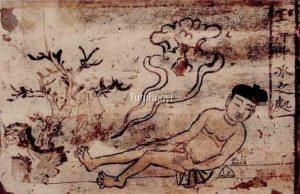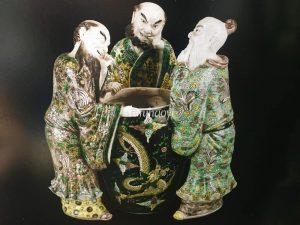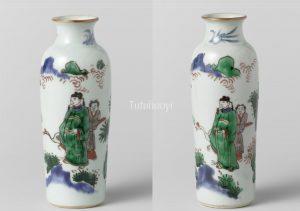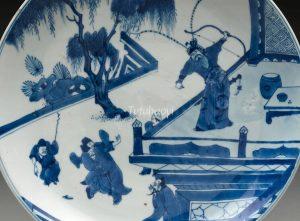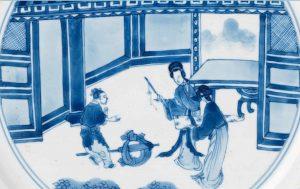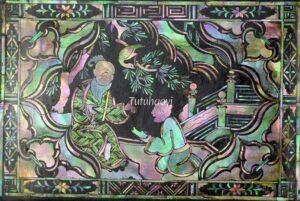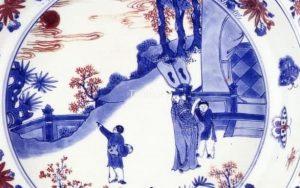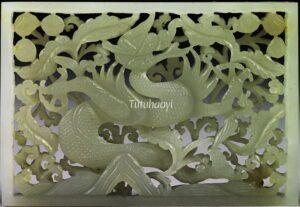Blogs
Interesting findings & case studies on commonly misunderstood and mystery images
Have you wondered why you often see an image of a man lying or ‘dancing’ beside a large fish on Chinese antiques? Is it referring to some figure and story in ancient China? Here is Dr Yibin Ni explaining to us the meaning of this touching story that reveals the traditional Chinese virtue of filial piety.
There have been a few interesting discussions even guesses on a mysterious scene which depicts mainly three figures surrounding a large bowl. The story scene actually comes from an important anecdote in Song dynasty in China. Let Dr Yibin Ni explain to you with fascinating details.
Have you ever been puzzled by the description of ‘figural paintings’ for Chinese porcelains listed by various museums and auction catalogues? In fact, many Chinese paintings with figures refer to ancient stories and have meanings behind the scenes. Here is an unusual story about an official and his pet crane.
Story scenes painted on Chinese porcelains are sometimes mysterious and challenging to understand. Dr Yibin Ni, whose specialised research is to demystify figures and story scenes, and decode motifs, symbols and pun rebuses in Chinese art, is here to tell the modern world about a story that happened two and a half thousand years ago in ancient China.
This blog is modified from Dr Yibin Ni’s research work first published on Antiques and Fine Art Magazine. The purpose is to appreciate how Chinese porcelain painters from ancient times passed on classical stories and illustrated traditional morals through their craftworks.
European descriptions of porcelain paintings that have story scenes tend to describe ‘figures and surroundings’, rather than identifying them. Thus, a large part of those beautiful stories intended by pot painters was lost in the description. Here are some examples…
Have you ever seen such an image and wondered why a young man is holding a shoe and kneeling down in front of an old man? Is there any historical event relating to the shoe and such scene? Read on to see how Dr Yibin Ni deciphers the figures and stories for you.
In Chinese porcelain painting, it can be tricky to interpret a round disc in the sky as a sun or a moon. Knowledge of Chinese culture and pun rebuses are the keys to explain the meanings of the motifs and scenes correctly. Here are some examples…
What is the value of deciphering pictorial scenes on traditional Chinese artworks? What is the importance in identifying correct figures and story scenes on antiques? Here is the editor’s conversation with Dr Yibin Ni, an internationally renowned researcher on Chinese iconography.
The story of the statesman Bing Ji (丙吉) inquiring about a panting buffalo in ancient China has been illustrated in various forms in traditional Chinese art. It is meant to praise high-ranking officials who can prioritise their duties for their country. However, such famous story on Chinese porcelains has often been misinterpreted. Dr Yibin Ni has found out those mistakes on a number of occasions during his art research. Here is what he has to say.
CATEGORIES
RECENT POSTS
 October 03, 2022The ‘Double Yang Day’ in Chinese Traditional Festivals
October 03, 2022The ‘Double Yang Day’ in Chinese Traditional Festivals July 20, 2022Pictorial Presentations of the Story of Cowherd and the Weav ...
July 20, 2022Pictorial Presentations of the Story of Cowherd and the Weav ... June 25, 2022Pictorial Presentation of Amitabha and the Two Assistant Bod ...
June 25, 2022Pictorial Presentation of Amitabha and the Two Assistant Bod ... May 16, 2022Hongwu Porcelain – The Treasure in Ming Dynasty Founded by Z ...
May 16, 2022Hongwu Porcelain – The Treasure in Ming Dynasty Founded by Z ... April 09, 2022How did Guo Ziyi deter the colossal enemy army without fight ...
April 09, 2022How did Guo Ziyi deter the colossal enemy army without fight ...
Archives
- October 2022
- July 2022
- June 2022
- May 2022
- April 2022
- March 2022
- February 2022
- January 2022
- December 2021
- November 2021
- October 2021
- September 2021
- August 2021
- July 2021
- June 2021
- May 2021
- April 2021
- March 2021
- February 2021
- January 2021
- December 2020
- November 2020
- October 2020
- September 2020
- August 2020
- July 2020
- June 2020
- May 2020
- April 2020
